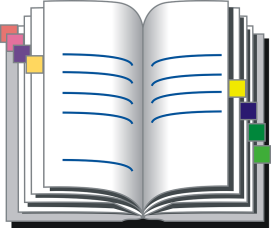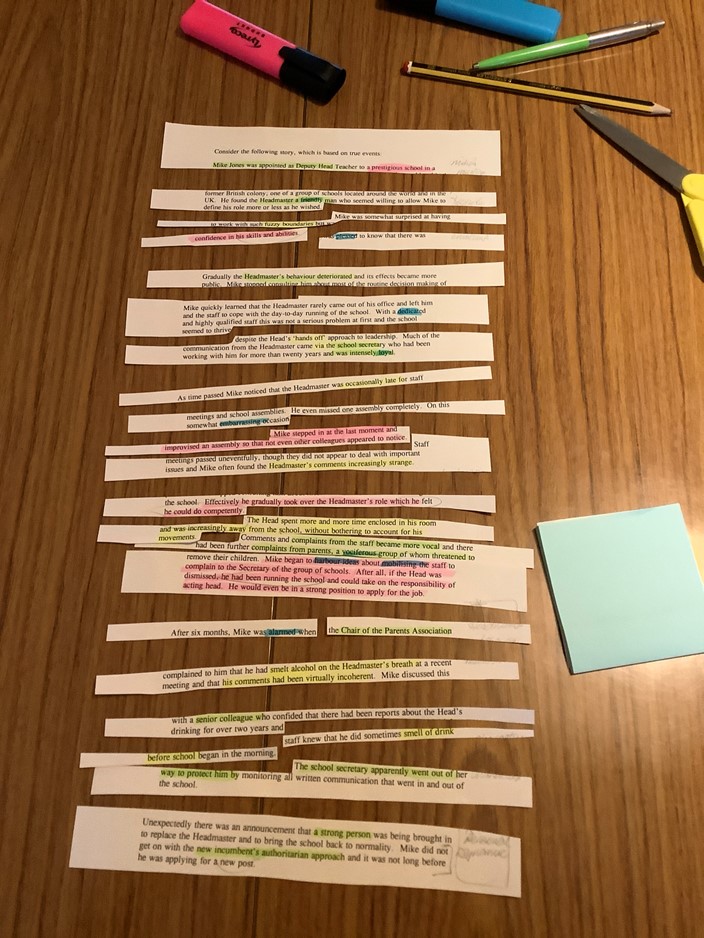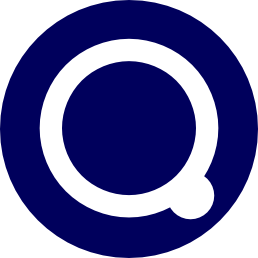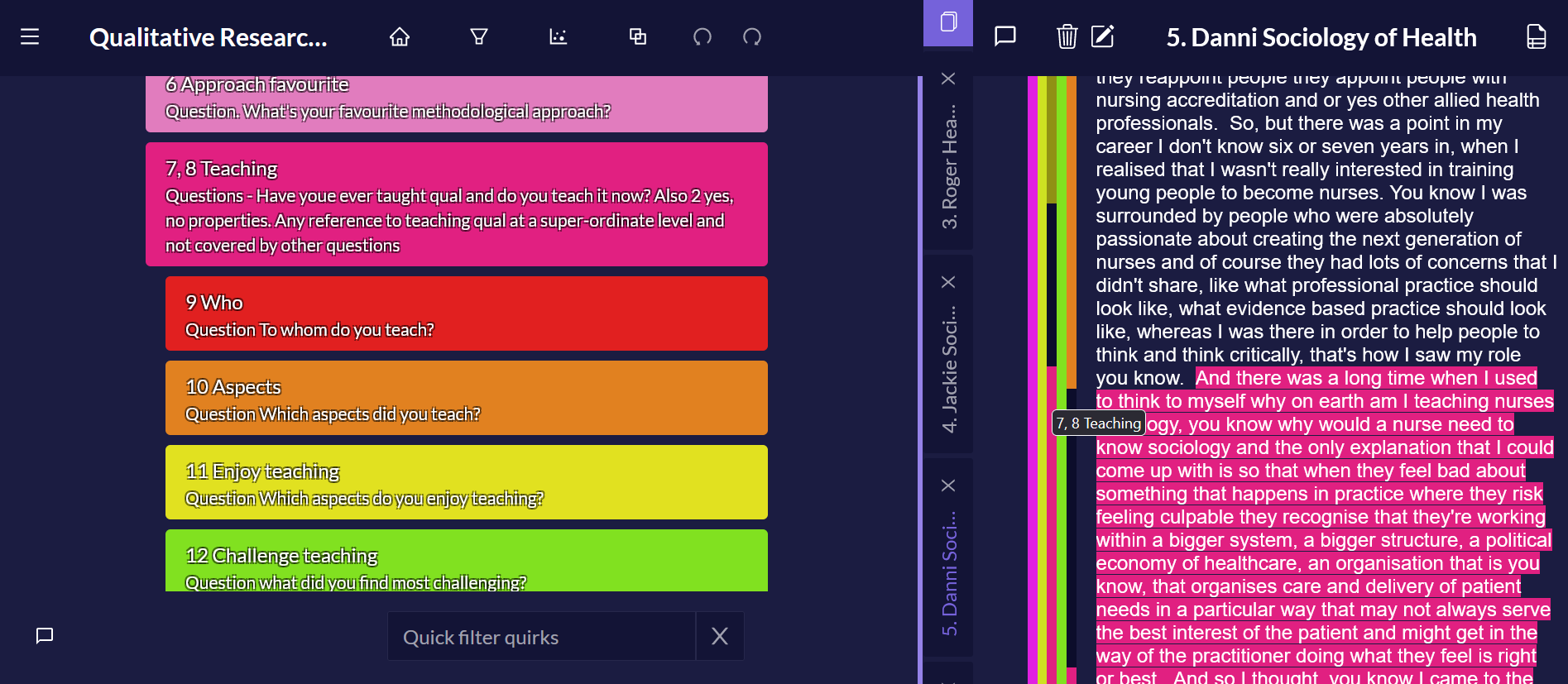Doing Qualitative Research: Manage and handle data
Managing qualitative data
It’s very easy to start a qualitative project thinking it will just be a few interviews and some basic thematic analysis; it won’t be difficult to keep track of it all, will it?
Having thought about setting up your research, possibly having gathered some data and maybe even begun the analysis process, we need to take a step back in our process and consider how we manage and handle that data, before it gets out of hand.
The cogs in the diagram represent the iterative nature of qualitative research. Turning any of the cogs will cause the other cogs to turn. Inputting into this system at any point, will cause the other elements of the system to change. You might just reflect on some notes, causing different analytical themes to emerge. You may even collect more data or even change some of the design. Most likely, you will go back and look at your analysis and query the data with different questions. Keeping track of what you are doing gets harder and messier as you go on. Poor administration of your research could leave you open to the accusation of superficial cherry-picking of interesting data fragments. You need to be able to demonstrate management of the emergence of your thinking, and of the project documentation e.g. is this the 3rd version of the verified transcript or the 2nd? Where else in the data will I find this theme? What else is associated with this theme? Show me!
If you are a doctoral student this plan is important, as you will be expected to understand and justify why you have chosen a particular action above and beyond pragmatic or utilitarian reasoning. Understanding your own handling process is fundamental to meaningful and rigorous qualitative research. This page focuses on how to handle and manage qualitative data, whether you are using our software or not. However if you are simply interested in getting started in Quirkos, a simple tool to help you manage and analyse qualitative data, you can see our quick guide below:
Elements of data processing
It doesn’t matter whether you are using analogue (paper) or digital methods (Word and Excel[1]) or even a specialist computer-aided qualitative data analysis software (CAQDAS) like Quirkos, the elements are the same[2]. You will need a system for handling and managing your data.
Textual data
- Interview transcripts and other data to work with

Coding framework
- Record of code descriptions
- Predetermined labels/codes
- Emerging labels/codes

Management system
- Cross-referenced indexing file
- How do we find things in the data?
- What properties does my data have?

Transformation system
- Visualising the coding of the data
- Tools for thinking and writing
- Exploring the data

Data
Qualitative research often uses written material as data. E.g transcripts and field notes. (Even where the data is visual, such as artefacts, video records, photographs and drawings, or diagrams, such as group interactions, you will produce text descriptions as part of your analysis). Whether you use a theory-led approach (e.g. framework analysis) or data led approach (e.g. Grounded Theory), you will need a record of any labels, codes and notes about your data data, and where to find it. Simply leafing through a few hundred pages of notes is probably not adequate or robust analysis.

Coding Framework
As well as a system for identifying where in the data your codes/tag/labels or notes can be found, quickly seeing and searching for where they coincide is an important way of helping you to think about your data and generate new codes/tags/labels or new ways of thinking about your data. Simply having printed copies of coded transcripts or transcripts with notes, may be tricky: typically there would be a lot of cutting up your transcripts in order to group your emerging data.
Management system
You need a cross-referenced index system. A hard system would have multiple index cards or records so you could cross-reference all analysis items (e.g. Who else was talking about this item? Where is it? What else were they talking about at the time?). It can generate a LOT of paper.
Transformation system
To transform the data through analysis you will have various tools for visualising and thinking about the data. Lots of paper (again!), lots of different colour pens and tags, and multiple copies of all your data, and maybe some scissors. And your brain.
Processing data digitally
Textual data
- Interview transcripts
- Observations
- Research journals
- Imported secondary text (images and webpages)
Coding framework
- Predetermined labels/codes
- Labels/codes emerging from the data
Management system
- Where in the data can I find any particular code?
- What properties does my data have?
Transformation system
- Visualising the coding of the data
- Exploring the data
- Comparing the data
- Creating themes and interpretation
- Writing about the data
Transforming textual data digitally
The initial organisation of data (i.e. handling) may not seem very transformative but every time you handle data to create structure you are transforming the data e.g. labelling some data with a code, or link it to something else in a group, or putting codes together with a new concept label. Even when you transcribe oral data to create text you are handling and transforming the data.
In 20 years of teaching, almost all of my students have underestimated how difficult and time-consuming transcription can be. A good rule of thumb is 10 minutes of high quality audio will take 1 hour to transcribe and that’s for an experienced transcriber with a transcription protocol that they are familiar with. Specialist approaches, such as Jefferson protocols for Conversation Analysis, could take 1 hour for 1 minute of audio, or more. On the other hand, I have met large numbers who are in a rush to summarise data and skip over challenging detail, or detail which at first pass doesn't seem terribly relevant. They are missing out on the rewards that spending time with the raw data can bring. There are some strong opinions about transcription:
Examples
- Transcribing data yourself is a tedious waste of time
- Time spent transcribing your data is not wasted; it is time familiarising yourself with your raw data, and all its important non-verbal detail
- Allowing others to transcribe takes you away from the data, and you are unlikely to spend as much time with written transcripts
- It doesn’t matter whether you spend time transcribing data yourself or reading a high quality transcription done by someone else. Or perhaps you will just analyse directly from a recording of some sort; you just need to spend time with your data
- Automated services are poor quality and expensive
- The use of artificial intelligence has some insidious risks
What opinions have you heard about transcription?
- Use your notebook to list and consider your options
- Then read the blogs below to help you finalise your decision
Coding framework

Keeping a record of codes and their descriptions in a code-book is a simple thing which can be achieved through simple means; A-Z note-books, Index Cards or an Excel spreadsheet. However, once you start to apply your codes, and generate new ones, it gets more time-consuming. Then when you really get into the depth of your analysis and thinking, you will want your coding framework to evolve. Keeping track of that gets difficult and messy. Using any CAQDAS can help you be efficient and more consistent with applying and changing, your frameworks.
Read more on coding frameworks:
Why not get started on your codebook now?
Management system
The key to good qualitative research is to transform your data in a credible way, creating a chain of evidence of what you did to handle the data (practical), and recording how, where and when new conceptualisations of data emerged and were transformed (theoretically/conceptually) through coding and writing. CAQDAS can help enormously in managing your data, and assist you in transforming your data quickly. They can seem laborious to set up or learn how to use, but they are no more time consuming than paper methods, and they pay dividends when it comes to the tools of searching, finding and helping you think about the connections in your data, and Quirkos is particularly good at helping you visualise your data.
“Integrating teaching and learning of the principles of qualitative methods with the techniques of using CAQDAS-packages involves bringing together understandings about what is planned in an analysis – the strategies – with how they can be accomplished using CAQDAS-packages – the tactics.”
(Silver and Woolf, 2019)[3]
It can be confusing to distinguish between your analytic strategies and the tactics you apply using the software, when clicking unfamiliar software buttons. So it is perhaps one of the reasons why so many people stick with paper. But as Daniel says in our blog:
“Think of it as your own data repository…
Since Quirkos imports the full text of your sources from the documents you import into the project file, you can keep all your research data in one place … No more searching for folders where you’ve hidden that missing transcript!
… the project can be password protected, you can also ensure the security and confidentiality of the data inside it.”
(Daniel Turner, 2019)[4]
CAQDAS are management systems. I can retrieve where in the source document any particular coding is to be found, what other coding it intersects with and which source properties (such as gender) are shared across those codes. CAQDAS makes this retrieval more reliable, easier and faster than paper or simple digital document methods (e.g. Word or Excel). There you might have to have multiple files and copies of documents and excellent record-keeping methods in order to find things.
Transformation and Analysis system
As well as managing data, CAQDAS are also systems that assist you in the analysis and transformation of your data. They do this by offering you tools to retrieve parts of the data, and tools to label and model the data. It is important to note that you can do everything that CAQDAS can do with coloured pens/highlighters, paper, scissors, glue; it might just take you longer and perhaps won’t look so presentable.
You will learn much more in the next section ❔ Analyse and transform data, but a little context on how your management system is implicated in your analysis and visa-versa is helpful in understanding just how important your management system is. An effective management system should allow you to engage in the function of analysis, e.g.
- Exploring the data
- Comparing the data
- Creating themes and interpretation
- Reflecting on the data
- Writing about the data
And CAQDAS, should also facilitate you in
- Visualising the coding of the data. This is just one of the things that makes Quirkos awesome. (Read the other six in the blog cited below[5])
Read and reflect in your notebook. Note that this blog is from 2016 - the features are the same, but we think they look better in the new Web version!
The vital caveat
The vital caveat to analysis and transformation is that the software cannot think. It will only do what you tell it to do. It cannot create labels for you. It cannot create models linked to the data if you haven’t labelled any data. It cannot think for you, even in tools that claim to offer 'AI' or machine learning, there are limits and biases that mean you can't stop thinking and critiquing yourself.
There is a phrase in the world of coding; RIRO - Rubbish In, Rubbish Out. This means that CAQDAS will not do your analysis for you.
CAQDAS will not do your analysis for you.
But it can help speed up the process and help you manage it so others can follow, understand and evaluate your process.
Where next?
Having considered how important management systems are in the process of producing credible and reliable qualitative data and analysis, you might like to go back to 🎙️ Gather data and re-evaluate some of your field-note pro-formas and aide-memoires. Some consistency in those documents can really help you manage those documents when it comes to coding and analysis later. Or you may like to move on to ❔ Analyse and transform data. Remember you can use the model at the top to go anywhere you like in this curated course.
Optional materials and resources
Data sources
Coding frameworks
Data Management plans
Go back to the Data Management section of the 💭 Epistemology and Meta issues page if you need a reminder of the requirements for a Data Management Plan. The most generally relevant guide for qualitative research (in the UK) is probably ESRC’s policy on research data planning.
Tell us what you think!
We'd love to hear from you so we can make this course as useful as possible. If you'd like to leave feedback, suggestions or comments, please use the button below.
Fill out our surveyCitations
[1] Turner, D (2017). Comparing qualitative software with spreadsheet and word processor software. Quirkos blog.
[2] Turner, D (2017). Quirkos vs Nvivo: Differences and Similarities. Quirkos blog.
[3] Silver, C., Bulloch, S. L., Salmona, M., and Woolf, N. (2023) 'Integrating the online teaching of qualitative analysis methods and technologies: challenges, solutions and opportunities', in Handbook of Teaching and Learning Social Research Methods. Edward Elgar Publishing, Cheltenham, p. 320.
[4] Turner, D (2019). How to use qualitative analysis software (QDAS) for data management. Quirkos blog.
[5] Turner, D (2017). 7 unique things that make Quirkos awesome. Quirkos blog.
How to cite this course
A simple bibliographic reference (where you are not citing anything in particular from the course) can be given as:
- Gibbons, C.A. (2024) Doing Qualitative Research. Quirkos.com https://www.quirkos.com/curated-course/index.html
However, if you are citing or quoting from the course content then the full URL should be given in the Reference section. E.g. If you want to cite the text or exercises around Ethics, the citation would be:
- Gibbons, C.A. (2024) Doing Qualitative Research. Quirkos.com https://www.quirkos.com/curated-course/epistemology.html#EthicalReview
Click here for more information on how to cite resources from Quirkos.
Try today!
Ready to give Quirkos a try? Register for a free 14-day trial of Quirkos today,
with no restrictions on features or
projects.with no restrictions on features or
projects.
Want to learn more? Read more about our features or see Quirkos in action!




